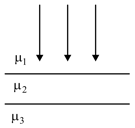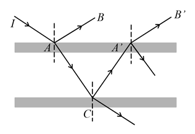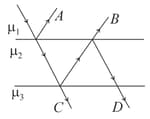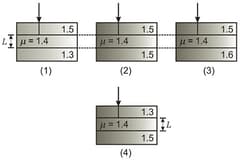Interference in Thin Films
Interference in Thin Films: Overview
This topic covers concepts, such as, Interference in Thin Films, Constructive Interference of Refracted Waves from Thin Film for Normal Incidence & Destructive Interference of Refracted Waves from Thin Film for Normal Incidence etc.
Important Questions on Interference in Thin Films
When Two waves of same amplitude add constructively, the intensity becomes _____
What is the main principle used in Interference?
_____ does not show any interference pattern?
A soap film of refractive index 1.33 is illuminated by the light of wavelength at an angle of 45 degrees. There is complete destructive interference. For, find the thickness of the film.
Given Refractive index = 1.33, i =
When light is incident on a soap film of thickness , the wavelength of light reflected maximum in the visible region is . The refractive index of the film will be:
A lens made out of a material of refractive index, is coated with a thin film of refractive index in order to reduce the reflection from its surface at . The minimum thickness of the film which will minimise the intensity of the reflected light is (assume near normal incidence)
When a thin transparent sheet of refractive index, is placed in front of one of the slits in YDSE, the intensity at the centre of the screen reduced to of the maximum intensity. The minimum thickness of the sheet should be [ is the wavelength of light]
A thin layer of oil (index of refraction and thickness ) floats on the surface of the liquid (index of refraction ). Now, white light is normally incident on the thin film of oil. Of the following, the most reflected wavelength is
Consider a case of thin film interference as shown in the figure. Thickness of film is equal to wavelength of light in

Assertion: Thin films such as soap bubble or a thin layer of oil on water show beautiful colours when illuminated by white light.
Reason: It happens due to the interference of light reflected from the upper surface and lower surface of the thin film.
Assertion: Thin films such as soap bubble or a thin layer of oil spread on water show beautiful colours when illuminated by white light.
Reason: It is due to interference of sun's light reflected from upper and lower surfaces of the film.
Assertion: Thin film such a soap bubble or a thin layer of oil on water show beautiful colours when illuminated by monochromatic light.
Reason: Colour in film are obtained due to interference between reflected light from the upper & lower layer of film
Find the thickness of a soap film that gives constructive second order interference of reflected red light The index of refraction of the film is 1.33. Assume a parallel beam of incident light directed at to the normal.
A ray of light of intensity is incident on a parallel glass-slab at the point and it undergoes partial reflection and refraction as shown in the figure. At each reflection, of the incident energy is reflected and the rest is transmitted. If the rays , and undergo interference, then the ratio is

A ray of light is incident on a thin film as shown in the figure. and are two reflected rays from first surface and are two final transmitted rays. Rays and undergo a phase change . Choose the correct relation among refractive indices is

Consider a film of thickness L, as shown in four different cases below, Notice the observation of film with perpendicularly falling light. Mark the correct statement(s).

(Take )
A thin film of thickness t and index of refraction 1.33 coats a glass with index of refraction 1.50. What is the test thickness t that will strongly reflect light with wavelength 600 nm incident normally ?
An observer looks down on two glass plates, one placed on top of the other. The top plate pivots about a line of contact at its edge as shown in the figure.The angle created by the pivoting motion increases in time. Which is true?

Interference pattern is observed at 'P' due to superimposition of two rays coming out from a source 'S' as shown in the diagram. The value of ' ' for which maxima is obtained at 'P' is :
(R is perfect reflecting surface) :

